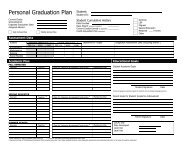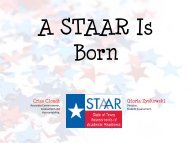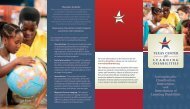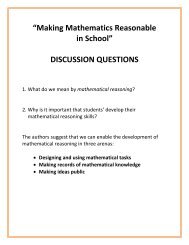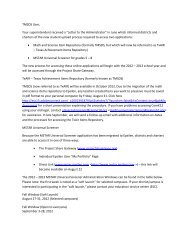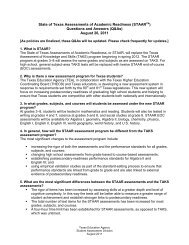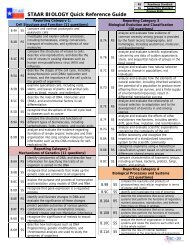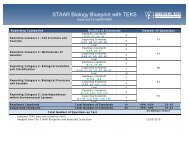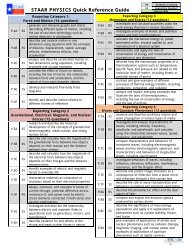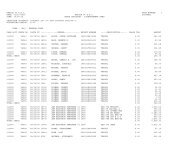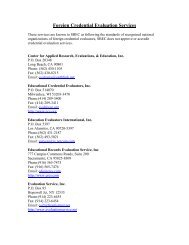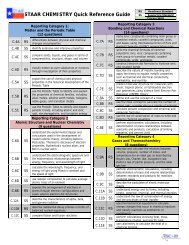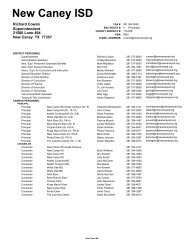STAAR 8th QRG
STAAR 8th QRG
STAAR 8th QRG
Create successful ePaper yourself
Turn your PDF publications into a flip-book with our unique Google optimized e-Paper software.
Reporting Category 4:<br />
Organisms and Environments (14 questions)<br />
describe producer/consumer, predator/prey,<br />
8.11A RS<br />
and parasite/host relationships as they<br />
occur in food webs within marine,<br />
freshwater, and terrestrial ecosystems<br />
investigate how organisms and populations<br />
in an ecosystem depend on and may<br />
8.11B RS compete for biotic and abiotic factors such<br />
as quantity of light, water, range of<br />
temperatures, or soil composition<br />
explore how short-and long-term<br />
8.11C RS environmental changes affect organisms<br />
and traits in subsequent populations<br />
recognize human dependence on ocean<br />
8.11D SS<br />
systems and explain how human activities<br />
such as runoff, artificial reefs, or use of<br />
resources have modified these systems<br />
7.10B SS<br />
describe how biodiversity contributes to the<br />
sustainability of an ecosystem<br />
observe, record, and describe the role of<br />
7.10C SS ecological succession such as in a<br />
microhabitat of a garden with weeds.<br />
examine organisms or their structures such<br />
7.11A SS as insects or leaves and use dichotomous<br />
keys for identification<br />
identify some changes in genetic traits that<br />
have occurred over several generations<br />
7.11C SS<br />
through natural selection and selective<br />
breeding such as the Galapagos Medium<br />
Ground Finch (Geospizafortis) or domestic<br />
animals<br />
identify the main functions of the systems<br />
of the human organism, including the<br />
7.12B SS<br />
circulatory, respiratory, skeletal, muscular,<br />
digestive, excretory, reproductive,<br />
integumentary, nervous, and endocrine<br />
systems<br />
differentiate between structure and function<br />
in plant and animal cell organelles, including<br />
7.12D SS cell membrane, cell wall, nucleus,<br />
cytoplasm, mitochondrion, chloroplast, and<br />
vacuole<br />
recognize that according to cell theory all<br />
7.12F SS<br />
organisms are composed of cells and cells<br />
carry on similar functions such as extracting<br />
energy from food to sustain life<br />
compare the results of uniform or diverse<br />
7.14B SS offspring from sexual reproduction or<br />
asexual reproduction<br />
recognize that inherited traits of individuals<br />
7.14C SS<br />
are governed in the genetic material found<br />
in the genes within chromosomes in the<br />
nucleus<br />
identify the basic characteristics of<br />
organisms, including prokaryotic or<br />
6.12D SS<br />
eukaryotic, unicellular or multicellular,<br />
autotrophic or heterotrophic, and mode of<br />
reproduction, that further classify them in<br />
the currently recognized Kingdoms<br />
Process Skills<br />
Embedded in at least 40% of the questions<br />
demonstrate safe practices during laboratory and field<br />
8.1A investigations as outlined in the Texas Safety<br />
Standards<br />
practice appropriate use and conservation of resources,<br />
8.1B<br />
including disposal, reuse, or recycling of materials<br />
plan and implement comparative and descriptive<br />
investigations by making observations, asking well-<br />
8.2A<br />
defined questions, and using appropriate equipment<br />
and technology<br />
design and implement comparative and experimental<br />
investigations by making observations, asking well-<br />
8.2B<br />
defined questions, formulating testable hypotheses,<br />
and using appropriate equipment and technology<br />
collect and record data using the International System<br />
8.2C of Units (SI) and qualitative means such as labeled<br />
drawings, writing, and graphic organizers<br />
construct tables and graphs, using repeated trials and<br />
8.2D<br />
means, to organize data and identify patterns<br />
analyze data to formulate reasonable explanations,<br />
8.2E communicate valid conclusions supported by the data,<br />
and predict trends<br />
in all fields of science, analyze, evaluate, and critique<br />
scientific explanations by using empirical evidence,<br />
logical reasoning, and experimental and observational<br />
8.3A<br />
testing, including examining all sides of scientific<br />
evidence of those scientific explanations, so as to<br />
encourage critical thinking by the student<br />
use models to represent aspects of the natural world<br />
8.3B such as an atom, a molecule, space, or a geologic<br />
feature<br />
identify advantages and limitations of models such as<br />
8.3C<br />
size, scale, properties, and materials<br />
relate the impact of research on scientific thought and<br />
8.3D society, including the history of science and<br />
contributions of scientists as related to the content<br />
use appropriate tools to collect, record, and analyze<br />
information, including lab journals/notebooks, beakers,<br />
meter sticks, graduated cylinders, anemometers,<br />
8.4A psychrometers, hot plates, test tubes, spring scales,<br />
balances, microscopes, thermometers, calculators,<br />
computers, spectroscopes, timing devices, and other<br />
equipment as needed to teach the curriculum<br />
use preventative safety equipment, including chemical<br />
splash goggles, aprons, and gloves, and be prepared to<br />
8.4B<br />
use emergency safety equipment, including an<br />
eye/face wash, a fire blanket, and a fire extinguisher<br />
Readiness<br />
Standards<br />
Supporting<br />
Standards<br />
Number of<br />
Standards<br />
Number of Questions<br />
15 60 – 65% 32 – 35<br />
34 35 – 40% 19 – 22<br />
50 Multiple Choice and 4Griddable



